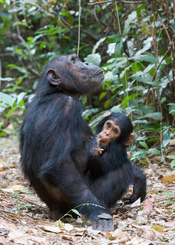It's pretty good--lots of facts on the topic Well written and good references!
I surrender all copyrights to Jens Shriver.
The acts of cannibalism and infanticide are very apparent in the behavior of the chimpanzee. Many African studies show that wild chimpanzees kill and eat infants of their own species. (Goodall, 1986:151) Although there is not a clear answer why chimps engage in this very violent and sometimes gruesome behavior there are many ideas and suggestions. This essay will deal with chimpanzee aggression, cannibalism and infanticide. This paper will present information on major research studies performed in Africa and analyze how and why this strange behavior occurs in a commonly thought peaceful primate.
Wild chimpanzees(Pan troglodytes schweinfurthii) are known to kill and eat mammals in various parts of Africa. Monkeys were recorded to be consumed in the Gombe National Park, the Kasakati Basin, and the Budongo Forest. Moreover, there is new evidence that chimpanzees near the Ugalla River of western Tanzania also consume mammals.(Riss,
1990:167) Cannibalism has also been recorded both in the Budongo Forest, Mahale Mountains and the Gombe National Park.
In Jane Goodall's, May 1979 article in the National Geographic called 'Life and Death at Gombe' it reveals the first time that chimpanzees who were always perceived to be playful, gentle monkeys, could suddenly become dangerous killers. 'I knew that some of our chimpanzees, so gentle for the most part, could on occasion become savage killers, ruthless cannibals, and that they had their own form of primitive warfare.'(Goodall, 1979:594) To try and explain this ruthless behavior it is necessary to first analyze their social upbringing and unique lifestyle.
The Chimpanzee society is clearly a male dominated aggressive social unit. Males are larger than females, they are more openly aggressive, and they fight more often. (Holloway,


